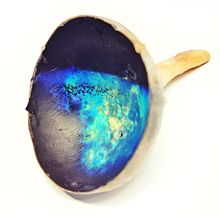
Back بساط شفاف Arabic Tapetum lucidum BS Tapetum lucidum Catalan Tapetum lucidum Czech Tapetum lucidum German Tapetum lucidum Spanish Tapetum lucidum Basque پرده درخشان Persian Tapetum lucidum Finnish Tapetum lucidum French


The tapetum lucidum (Latin for 'bright tapestry, coverlet'; /təˈpiːtəm ˈluːsɪdəm/ tə-PEE-təm LOO-sih-dəm; pl.: tapeta lucida)[1] is a layer of tissue in the eye of many vertebrates and some other animals. Lying immediately behind the retina, it is a retroreflector. It reflects visible light back through the retina, increasing the light available to the photoreceptors (although slightly blurring the image). The tapetum lucidum contributes to the superior night vision of some animals. Many of these animals are nocturnal, especially carnivores, while others are deep sea animals.
Similar adaptations occur in some species of spiders.[2] Haplorhine primates, including humans, are diurnal and lack a tapetum lucidum.[Note 1]
- ^ "Latin Word Lookup". Archives.nd.edu. Retrieved 2014-03-20.
- ^ Ruppert, E. E.; Fox, R. S.; Barnes, R. D. (2004). "Chelicerata: Araneae". Invertebrate Zoology (7th ed.). Brooks/Cole. pp. 578–81. ISBN 978-0-03-025982-1.
- ^ Cite error: The named reference
Ollivier+2004was invoked but never defined (see the help page).
Cite error: There are <ref group=Note> tags on this page, but the references will not show without a {{reflist|group=Note}} template (see the help page).
© MMXXIII Rich X Search. We shall prevail. All rights reserved. Rich X Search